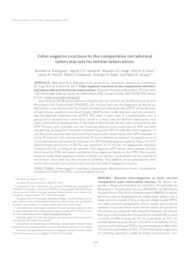False-negative reactions to the comparative intradermal tuberculin test for bovine tuberculosis.
False-negative reactions to the comparative intradermal tuberculin test for bovine tuberculosis.
Author(s): RODRIGUES, R. A.; MENESES, I. I. F. S.; JORGE, K. S. G.; SILVA, M. R.; SANTOS, L. R. dos; LILENBAUM, W.; ETGES, R. N.; ARAUJO, F. R.
Summary: According to the Brazilian National Program for the Control and Eradication of Animal Brucellosis and Tuberculosis (PNCEBT), the routine tests for the diagnosis of bovine tuberculosis in the country are the simple intradermal tuberculin test (SITT) of the Ministry of Agriculture, Livestock and Food Supply (MAPA), the caudal fold test and the comparative intradermal tuberculin test (CITT). The latter is also used as a confirmatory test. A group of 53 animals from three dairy herds in a focal area for bovine tuberculosis, that were submitted to depopulation in the state of Rio Grande do Sul, were submitted to the CITT. Tissues were cultured and the resulting colonies were confirmed by PCR and DNA sequencing. Among the 53 animals analyzed using the CITT, 32 (60.4%) were negative, 14 (26.4%) were positive and seven (13.2%) results were inconclusive. The CITT detected 11 of the 39 animals with culture-confirmed M. bovis infection as positive. Among the total of 14 uninfected animals based on cultures, the CBT detected eight as negative. Thus, the CITT demonstrated sensitivity of 28.2% and specificity of 57.1% for the population sampled. A total of 24/32 (75.0%) of the animals with negative CITT results were culture positive (confirmed by PCR) and were considered false negatives based on the CITT. The maintenance of these false-negative animals in herds has serious implications for the control of the disease, since they can be a source of infection. The addition of complementary tests could help identify such animals and increase the odds of diagnostic success.
Publication year: 2017
Types of publication: Journal article
Unit: Embrapa Beef Cattle
Observation
Some of Embrapa's publications are published as ePub files. To read them, use or download one of the following free software options to your computer or mobile device. Android: Google Play Books; IOS: iBooks; Windows and Linux: Calibre.
Access other publications
Access the Agricultural Research Database (BDPA) to consult Embrapa's full library collection and records.
Visit Embrapa Bookstore to purchase books and other publications sold by Embrapa.

